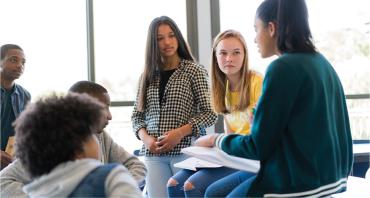As the research shows, implicit biases pervade our culture, yet people are often unaware they even hold them. For adults, these biases can be difficult to navigate. For children of color, their effects can be detrimental. Implicit biases toward minority students can result in difficulties with peer acceptance in school, more teacher-student conflict, more frequent and unequal punishments, and challenges with academic performance.
As educators, we already face an uphill battle when it comes to tackling both implicit and explicit biases in our schools. But when incidents of prejudice, stereotyping, and even hate make headlines each day, the job of teaching and caring for all students becomes even more difficult. And while this topic can feel overwhelming at times, the teachers and contributors at Share My Lesson have some tips for how you can support students who encounter bias on a regular basis—whether in school or at home.
Create a Safe Space
How safe is your classroom? As educators, we of course strive to create spaces that allow students to feel like they can honestly be themselves, but when bias enters the classroom, that feeling of safety may fade. Among the first steps in creating a welcoming classroom culture is to understand implicit bias.
For more on its impact on individuals and school communities, check out “Patterns and Perceptions: Breaking Down Implicit Bias,” a webinar by the Anti-Defamation League, a Share My Lesson contributor. This resource suggests ways teachers can establish and maintain the idea of a safe space in their classes, such as being public and purposeful about being inclusive of all students; explicitly teaching about our differences, stereotypes, and biases; and establishing and promoting clear values about respect and regard for others. Another resource, “Empowering Young People in the Aftermath of Hate:
A Guide for Educators and Families,” features lessons on teaching students about empathy and positive self-esteem development, as well as engaging them in discussions of overcoming prejudice.
Honor and Respect Feelings
With so many reports of hate in the news, students are hardly immune to what they are reading on the Internet and hearing from their friends. As a result, it’s important that students have opportunities to engage in honest and open discussions about their feelings (if they wish to discuss them) and feel like they are being heard. To that end, the following resources may help: “Addressing Racism & Stereotyping with Students,” “Helping Students Make Sense of News Stories about Bias and Injustice,” and “When Hate Is in the Headlines: Resources for K–12 Educators.” Also, be sure to check out the webinar featured in the last resource, hosted by experts from the American Federation of Teachers and the Anti-Defamation League, as well as other Share My Lesson contributors, such as Facing History and Ourselves and the Southern Poverty Law Center’s Teaching Tolerance project.
In particular, Facing History and Ourselves offers tips such as the need to engage in culturally responsive teaching and the importance of knowing your students’ backgrounds and understanding where your identities do and do not intersect. Additionally, educators are encouraged to “be a student of yourself,” meaning that you examine and understand your privilege and your potential blind spots.
Classroom conversations on bias are times when, as a teacher, you can and should be learning more about yourself as well. Your students will appreciate your willingness both to engage in these discussions and to be open with them. Finally, don’t forget to look through Share My Lesson’s “Today’s News, Tomorrow’s Lesson” section to find more ideas for talking to your students about bias and hate in the news.
We hope these resources empower you in teaching children the need for tolerance, safety, and respect in all our lives. If you have additional ideas or requests, please reach out to us at content@sharemylesson.com.
–THE SHARE MY LESSON TEAM

